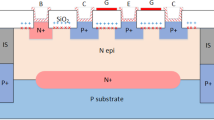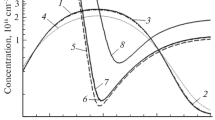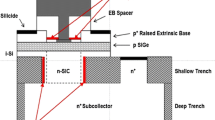Abstract
Elevated temperature irradiation (ETI) is performed on the specially designed GLPNP transistors. Two temperatures rather than one are found to most efficiently promote the growth of traps on SiO\(_2\)/Si interface. The activation energies of the generation process near either optimum temperature (\(T_C\)) are approximately 0.88eV and 0.56eV, which imply at least two defect precursors are involved. Analysis suggest that the unusual two \(T_C\) should result from different mechanisms, which involved the competition between the conversion of charged traps to interface traps and the annealing of either hole traps or interface traps.









Similar content being viewed by others
Availability of data and material
All data generated or analyzed during this study are included in this published article.
References
J. Boch, F. Saigné, A. Touboul, S. Ducret, J.-F. Carlotti, M. Bernard, R. Schrimpf, F. Wrobel, G. Sarrabayrouse, Dose rate effects in bipolar oxides: Competition between trap filling and recombination. Appl. Phys. Lett. 88(23), 232113 (2006)
X. Chen, H. Barnaby, B. Vermeire, K. Holbert, D. Wright, R. Pease, G. Dunham, D. Platteter, J. Seiler, S. McClure et al., Mechanisms of enhanced radiation-induced degradation due to excess molecular hydrogen in bipolar oxides. IEEE Trans. Nucl. Sci. 54(6), 1913–1919 (2007)
H.P. Hjalmarson, R.L. Pease, R.A. Devine, Calculations of radiation dose-rate sensitivity of bipolar transistors. IEEE Trans. Nucl. Sci. 55(6), 3009–3015 (2008)
X.J. Chen, H.J. Barnaby, P. Adell, R.L. Pease, B. Vermeire, K.E. Holbert, Modeling the dose rate response and the effects of hydrogen in bipolar technologies. IEEE Trans. Nucl. Sci. 56(6), 3196–3202 (2009)
N.L. Rowsey, M.E. Law, R.D. Schrimpf, D.M. Fleetwood, B.R. Tuttle, S.T. Pantelides, A quantitative model for eldrs and h\(_2\) degradation effects in irradiated oxides based on first principles calculations. IEEE Trans. Nucl. Sci. 58(6), 2937–2944 (2011)
I.S. Esqueda, H.J. Barnaby, P.C. Adell, Modeling the effects of hydrogen on the mechanisms of dose rate sensitivity. IEEE Trans. Nucl. Sci. 59(4), 701–706 (2012)
D. Fleetwood, L. Riewe, J. Schwank, S. Witczak, R. Schrimpf, Radiation effects at low electric fields in thermal, simox, and bipolar-base oxides. IEEE Trans. Nucl. Sci. 43(6), 2537–2546 (1996)
S. Witczak, R. Schrimpf, H. Barnaby, R. Lacoe, D. Mayer, K. Galloway, R. Pease, D. Fleetwood, Moderated degradation enhancement of lateral pnp transistors due to measurement bias. IEEE Trans. Nucl. Sci. 45(6), 2644–2648 (1998)
G. Zebrev, D. Pavlov, V. Pershenkov, A. Nikiforov, A. Sogoyan, D. Boychenko, V. Ulimov, V. Emelyanov, Radiation response of bipolar transistors at various irradiation temperatures and electric biases: modeling and experiment. IEEE Trans. Nucl. Sci. 53(4), 1981–1987 (2006)
Y. Liu, G. Zhang, H. Zhou, X. Zuo, Y. Song, Y. Zhang, Modeling the eldrs effects in hydrogen-rich a-sio\(_2\) of a specific designed glpnp bipolar transistor. Eur. Phys. J. Plus 136(6), 1–17 (2021)
V. Pershenkov, D. Savchenkov, A. Bakerenkov, V. Ulimov, Conversion model of enhanced low-dose-rate sensitivity for bipolar ics. Russ. Microlectron. 39(2), 91–99 (2010)
V. Pershenkov, A. Sogoyan, V. Telets, Conversion model of radiation-induced interface-trap buildup and the some examples of its application. In: IOP Conference Series: Materials Science and Engineering, vol. 151, p. 012001 . IOP Publishing (2016)
S. Witczak, R. Schrimpf, D. Fleetwood, K. Galloway, R. Lacoe, D. Mayer, J.M. Puhl, R. Pease, J.S. Suehle, Hardness assurance testing of bipolar junction transistors at elevated irradiation temperatures. IEEE Trans. Nucl. Sci. 44(6), 1989–2000 (1997)
J. Boch, F. Saigné, R. Schrimpf, D. Fleetwood, R. Cizmarik, D. Zander, Elevated temperature irradiation at high dose rate of commercial linear bipolar ics. IEEE Trans. Nucl. Sci. 51(5), 2903–2907 (2004)
J. Boch, F. Saigné, V. Mannoni, F. Giustino, R. Schrimpf, L. Dusseau, K. Galloway, J. Fesquet, J. Gasiot, R. Ecoffet, Model for high-temperature radiation effects in npn bipolar-junction transistors. IEEE Trans. Nucl. Sci. 49(6), 2990–2997 (2002)
G.I. Zebrev, M.S. Gorbunov, Modeling of radiation-induced leakage and low dose-rate effects in thick edge isolation of modern mosfets. IEEE Trans. Nucl. Sci. 56(4), 2230–2236 (2009)
L. Dong, J. Yang, X. Yu, G. Lv, Y. Fan, X. Li, Evolution of ionization-induced defects in glpnp bipolar transistors at different temperatures. IEEE Trans. Nucl. Sci. 67(9), 2003–2008 (2020)
X.-L. Li, W. Lu, X. Wang, X. Yu, Q. Guo, J. Sun, M.-H. Liu, S. Yao, X.-Y. Wei, C.-F. He, Estimation of enhanced low dose rate sensitivity mechanisms using temperature switching irradiation on gate-controlled lateral pnp transistor. Chin. Phys. B 27(3), 036102 (2018)
P. McWhorter, P. Winokur, Simple technique for separating the effects of interface traps and trapped-oxide charge in metal-oxide-semiconductor transistors. Appl. Phys. Lett. 48(2), 133–135 (1986)
A. Ortiz-Conde, F.G. Sánchez, J.J. Liou, A. Cerdeira, M. Estrada, Y. Yue, A review of recent mosfet threshold voltage extraction methods. Microelectron. Reliab. 42(4–5), 583–596 (2002)
D.R. Ball, R.D. Schrimpf, H.J. Barnaby, Separation of ionization and displacement damage using gate-controlled lateral pnp bipolar transistors. IEEE Trans. Nucl. Sci. 49(6), 3185–3190 (2002)
A.T. Yastrebov, V.S. Pershenkov, A.S. Bakerenkov, V.A. Felitsyn, A.S. Rodin, V.V. Belyakov, V.V. Shurenkov The issue of using test dose rate 10 mrad (si)/s for eldrs prediction in mil-std-883-h. In: 2015 15th European Conference on Radiation and Its Effects on Components and Systems (RADECS), pp. 1–3 . IEEE (2015)
V. Pershenkov, D. Savchenkov, A. Bakerenkov, V. Ulimov, A. Nikiforov, A. Chumakov, A. Romanenko, The conversion model of low dose rate effect in bipolar transistors. In: 2009 European Conference on Radiation and Its Effects on Components and Systems, pp. 290–297 . IEEE (2009)
A. Bakerenkov, V. Belyakov, V. Pershenkov, A. Romanenko, D. Savchenkov, V. Shurenkov, Extracting the fitting parameters for the conversion model of enhanced low dose rate sensitivity in bipolar devices. Russ. Microlectron. 42(1), 48–52 (2013)
V. Pershenkov, A. Bakerenkov, A. Solomatin, V. Belyakov, The estimation of long time operation bipolar devices in space environment using conversion model of eldrs. In: 2013 14th European Conference on Radiation and Its Effects on Components and Systems (RADECS), pp. 1–4. IEEE (2013)
V.S. Pershenkov, V.A. Telets, A.S. Bakerenkov, A.S. Rodin, V.A. Felitsyn, V.V. Belyakov, Effect of elevated temperature irradiation on bipolar devices for space application. Radiation Effects and Defects in Solids (2019)
D. Fleetwood, W. Warren, J. Schwank, P. Winokur, M. Shaneyfelt, L. Riewe, Effects of interface traps and border traps on mos postirradiation annealing response. IEEE Trans. Nucl. Sci. 42(6), 1698–1707 (1995)
R. Stahlbush, B. Mrstik, R. Lawrence, Post-irradiation behavior of the interface state density and the trapped positive charge. IEEE Trans. Nucl. Sci. 37(6), 1641–1649 (1990)
R. Van Ginhoven, H. Hjalmarson, A. Edwards, B. Tuttle, Hydrogen release in sio2: Source sites and release mechanisms. Nucl. Instrum. Methods Phys. Res. Sect. B 250(1–2), 274–278 (2006)
Y. Yue, Y. Song, X. Zuo, First-principles investigations of proton generation in \(\alpha\)-quartz. Chin. Phys. B 27(3), 037102 (2018)
J.J. Tzou, J.Y.-C. Sun, C.-T. Sah, Field dependence of two large hole capture cross sections in thermal oxide on silicon. Appl. Phys. Lett. 43(9), 861–863 (1983)
F. Grunthaner, P. Grunthaner, J. Maserjian, Radiation-induced defects in sio2 as determined with xps. IEEE Trans. Nucl. Sci. 29(6), 1462–1466 (1982)
S. Lai, Interface trap generation in silicon dioxide when electrons are captured by trapped holes. J. Appl. Phys. 54(5), 2540–2546 (1983)
C.R. Helms, E.H. Poindexter, The silicon-silicon dioxide system: Its microstructure and imperfections. Rep. Prog. Phys. 57(8), 791 (1994)
Y. Yue, P. Li, Y. Song, X. Zuo, Dissociation characteristics of proton release in a-sio2 by first-principles theory. J. Non-Cryst. Solids 486, 1–8 (2018)
Y. Yue, J. Wang, Y. Zhang, Y. Song, X. Zuo, Interactions of atomic hydrogen with amorphous sio2. Physica B 533, 5–11 (2018)
L. Skuja, K. Kajihara, M. Hirano, A. Saitoh, H. Hosono, An increased f2-laser damage in wet silica glass due to atomic hydrogen: a new hydrogen-related e’-center. J. Non-Cryst. Solids 352(23–25), 2297–2302 (2006)
Y. Yue, B. Zhou, F. Zhang, P. Li, Y. Song, X. Zuo, Hydroxyl e’center and stress-assisted proton generation in hydrogen-rich amorphous silica. Comput. Mater. Sci. 182, 109760 (2020)
Acknowledgements
This work was supported by NSFC under Grant Nos. 11804313 and the State Key Laboratory of Nuclear Physics and Technology-Peking University under grant No.NPT2020KFY16.
Funding
This work was supported by NSFC under Grant Nos. 11804313 and the State Key Laboratory of Nuclear Physics and Technology-Peking University under grant No.NPT2020KFY16.
Author information
Authors and Affiliations
Contributions
All authors contributed to the study conception and design. Experiments, data collection, and analysis were performed by Hang Zhou. Parameter extraction was performed by Guanghui Zhang. The modeling and analytic analysis were performed by Yang Liu and Binghuang Duan. The first draft of the manuscript was written by Hang Zhou and revised by Yang Liu. All authors read and approved the final manuscript.
Corresponding author
Ethics declarations
Conflict of interest
All authors have received research funding from China Academy of Engineering Physics institution.
Rights and permissions
Springer Nature or its licensor (e.g. a society or other partner) holds exclusive rights to this article under a publishing agreement with the author(s) or other rightsholder(s); author self-archiving of the accepted manuscript version of this article is solely governed by the terms of such publishing agreement and applicable law.
About this article
Cite this article
Zhou, H., Zhang, G., Duan, B. et al. Unusual dual optimum temperatures for ionizing radiation-induced defect generation in GLPNP bipolar transistors. J Mater Sci: Mater Electron 34, 1119 (2023). https://doi.org/10.1007/s10854-023-10534-3
Received:
Accepted:
Published:
DOI: https://doi.org/10.1007/s10854-023-10534-3




